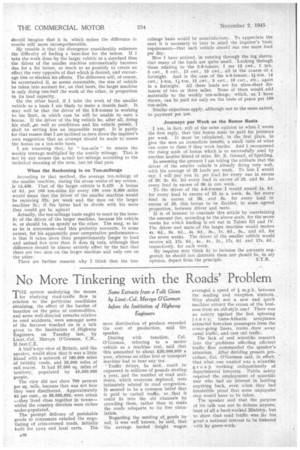No More Tinkering with the Roads' Problem
Page 32

If you've noticed an error in this article please click here to report it so we can fix it.
THE system underlying the means for studying road-traffic flow in relation to the particular conditions obtaining, the effect of the burden of taxation on the price of commodities, and some well-directed remarks relative to road accidents, were amongst -some of the features touched on in a talk given to the Institution of -Highway Engineers, on Tuesday last, by Lieut.-Col. Mervyn O'Gorman, C.B., M.Inst.C.E.
A bird's-eye view of Britain, said the speaker, would show that it was a little island with a network of 180,000 miles of twiddly roads, and 20,000 miles of rail routes. It had 57,000 sq. miles of territory, populated by 45,000,000 people_
The view did not show 790 persons per sq. mile, because that was not how they were distributed. Approximately 85 per cent., or 39,000,000, were urban —they .lived close together in towns.— whilst the country districts were rather under-populated.
The prompt delivery of perishable goods to consumers entailed the negotiating of criss-crossed roads, initially built for cows and local carts. The mere distribution of produce exceeded the cost of production, said the speaker.
Dealing with taxation, Col. O'Gorman, referring to a motor vehicle as a machine tool, said that this amounted to about £50,000,000 a year, whereas no other tool or transport machine had to bear any tax.
' Traffic delays, he said, could be expressed in millions of pounds sterling a year, and the number of road accidents, which everyone deplored, were intimately related to road congestion. It seemed to be a common belief that it paid to curtail traffic, so , that it could fit into the old channels by crowding them, rather than to make the roads adequate to its free circulation.
Regarding the sending of goods by rail, it was well known, he said, that the average loaded freight wagon averaged a speed of m.p.h. between the sending and reception stations.. Why should not a new and quick machine attract the cream of the business from an old-style one? There was an outcry against the first spinning jenn y; trans-Atlantic aeroplanes attracted first-class passengers from the ocean-going liners, trains drew away canal traffic, and cars rail traffic.
The lack of real scientific research into the -s problems affecting efficient trafficflow commanded the speaker's attention. After deriding present procedure, Col. O'Gorman said, in effect, – that what was wanted was a scientific gr oup working independently of departmental interests. Public safety required the employment of scientific men who had no interest in holding anything back, even when they had irresistible proof that some unpopular step would have to be taken.
The speaker said that the purpose of his talk was not to defame anyone, least of all a hard-worked Ministry, but to show that road traffic Ives far too great a national interest to be tinkered o ith by guess-work.




















































